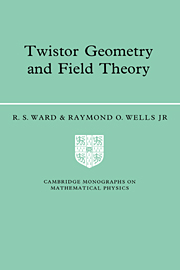10 - The Penrose transform for general gauge fields
from Part III - The Penrose transform
Published online by Cambridge University Press: 08 October 2009
Summary
In the previous three chapters we have seen how the Penrose transform maps essentially free holomorphic data on a twistor space to solutions of self-dual field equations in various contexts. There were two aspects to this program. The first was the formal transform (or correspondence) between holomorphic data and solutions of field equations. The second was using the specific transform to generate some (and sometimes all) of the solutions of the equations in a reasonably explicit manner. Some of these solutions, in particular for the nonlinear problems, had been unknown before using the techniques of the Penrose transform.
In the study of non-self-dual problems the results are much weaker. There is a systematic generalization of the Penrose transform which translates holomorphic data on more general twistor spaces to solutions of quite general field equations. These are primarily of the Yang–Mills–Higgs–Dirac type, and not necessarily with any type of self-duality condition. There is as yet no satisfactory transform from the general Einstein equations, although there are some partial results.
In this chapter we want to outline the principal results in this direction. The initial impetus came from the work of Isenberg, Yasskin and Green (1978) and Witten (1978), which represented solutions of the full Yang–Mills equations in terms of holomorphic vector bundles on formal neighborhoods of ambitwistor space.
- Type
- Chapter
- Information
- Twistor Geometry and Field Theory , pp. 459 - 484Publisher: Cambridge University PressPrint publication year: 1990



